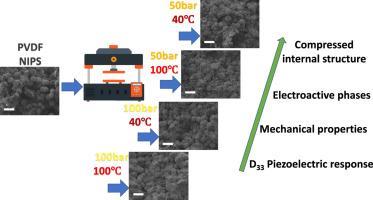Increased electroactive properties of poly(vinylidene fluoride) films by thermo-mechanical post-processing
IF 6.3
2区 材料科学
Q2 CHEMISTRY, PHYSICAL
引用次数: 0
Abstract
Due to its outstanding electroactive properties, poly(vinylidene fluoride) (PVDF) is widely used in the energy, electronic, and biomedical fields. In particular, the highly polar and electroactive β-phase obtained by low temperature solvent evaporation has numerous technological applications due to its piezo-, pyro- and ferroelectric properties, but typically presents a porous morphology. PVDF membranes were prepared by non-solvent induced phase separation (NIPS) from a dimethylformamide (DMF) solution, and post-processed by thermo-mechanical compression under varying temperature and pressure to produce solid films. The effect of these parameters on the morphology, β-phase content, thermal properties, crystalline phase content and piezoelectric response was evaluated. Thermo-mechanical treatment reduces porosity leading to a compact morphology, while also increases the βphase content and the degree of crystallinity. Also, it enhances the mechanical properties and increases the piezoelectric value. It is to notice that this simple processing method is compatible with the large-scale manufacturing of electroactive PVDF samples in an industrial setting.

热机械后处理提高聚偏氟乙烯薄膜的电活性
由于其优异的电活性,聚偏氟乙烯(PVDF)被广泛应用于能源、电子和生物医学领域。特别是,通过低温溶剂蒸发获得的高极性和电活性β相由于其压电、热电和铁电性质而具有许多技术应用,但通常呈现多孔形态。以二甲基甲酰胺(DMF)溶液为原料,采用非溶剂诱导相分离(NIPS)法制备PVDF膜,并在不同温度和压力下进行热机械压缩制备固体膜。考察了这些参数对形貌、β相含量、热性能、晶相含量和压电响应的影响。热处理减少了孔隙率,导致致密的形貌,同时也增加了β相含量和结晶度。同时,它还能提高材料的力学性能和压电值。值得注意的是,这种简单的加工方法与在工业环境中大规模制造电活性PVDF样品兼容。
本文章由计算机程序翻译,如有差异,请以英文原文为准。
求助全文
约1分钟内获得全文
求助全文
来源期刊

Surfaces and Interfaces
Chemistry-General Chemistry
CiteScore
8.50
自引率
6.50%
发文量
753
审稿时长
35 days
期刊介绍:
The aim of the journal is to provide a respectful outlet for ''sound science'' papers in all research areas on surfaces and interfaces. We define sound science papers as papers that describe new and well-executed research, but that do not necessarily provide brand new insights or are merely a description of research results.
Surfaces and Interfaces publishes research papers in all fields of surface science which may not always find the right home on first submission to our Elsevier sister journals (Applied Surface, Surface and Coatings Technology, Thin Solid Films)
 求助内容:
求助内容: 应助结果提醒方式:
应助结果提醒方式:


